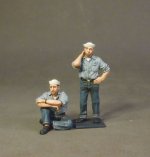INTER-WAR AVIATION
The Interwar Aviation series covers aircraft that were developed and used between World War 1 and World War 2, and was known as the “Golden Age of Aviation.”
In the two decades between the end of World War 1 and the start of World War 2, military aviation underwent a complete transformation. The typical combat aircraft of 1918 was a fabric-covered externally braced biplane with fixed landing gear and open cockpits. Few aero engines developed as much as 250 horsepower, and top speeds of 200 km (120 miles) per hour were exceptional. By 1939 the first-line combat aircraft of the major powers were all-metal monoplanes with retractable landing gear.
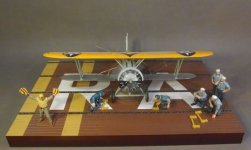
Most early aircraft carriers were conversions of ships that were laid down (or had even served) as different ship types: cargo ships, cruisers, battlecruisers, or battleships. During the 1920s, several navies started ordering and building aircraft carriers that were specifically designed as such. This allowed the design to be specialized to their future role, and resulted in superior ships. During the Second World War, these ships would become the backbone of the carrier forces of the US, British, and Japanese navies, known as fleet carriers.
USS Saratoga (CV-3) was a Lexington-class aircraft carrier built for the United States Navy during the 1920s. Originally designed as a battlecruiser, she was converted into one of the Navy's first aircraft carriers during construction to comply with the Washington Naval Treaty of 1922. The ship entered service in 1928 and was buttigned to the Pacific Fleet for her entire career. Saratoga and her sister ship, Lexington, were used to develop and refine carrier tactics in a series of annual exercises before World War II. On more than one occasion these included successful surprise attacks on Pearl Harbor, Hawaii. She was one of three prewar US fleet aircraft carriers, along with Enterprise and Ranger, to serve throughout World War II.
A U.S. Navy Aircraftcarrier’s deck crew exists to do one thing: to consistently put aircraft into the air and safely recover them after they launch. In order to make this happen, there exists a small army of flight deck facilitators, and each individual has their own role primarily designated by the color of the shirt they wear.
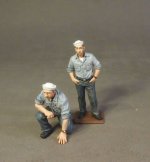
IWA-16
INTER-WAR AVIATION,
USS SARATOGA (CV-3),
SAILORS,
(2pcs)
Life on the flight deck is dangerous and taxing. Spinning propellers, grease everywhere, and a stiff sea wind that never stops are just a few of the things that must be endured for many hours at a time. The night and bad weather throw a whole other set of problems into the mix.
Yellow shirts are also worn by aircraft handlers and aircraft directors that shuttle aircraft around the carrier’s tight and chaotic deck.
Plane Handlers, who work under the direction of the yellow shirt wearing aircraft handlers, buttist in moving aircraft around the deck. They also can operate the carrier’s massive aircraft elevators, drive tractors and work as messengers and verbal liaisons.
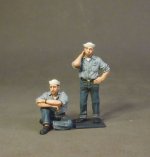
IWA-17
INTER-WAR AVIATION,
USS SARATOGA (CV-3),
SAILORS,
(2pcs)
** PLEASE NOTE THESE SETS WILL ALSO BE AVAILABLE WITH GREY BASES TO ACCOMPANY THE BH100-300 DECKS.**
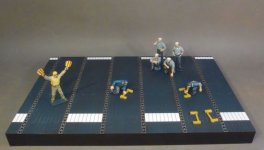
**PLEASE NOTE THAT THE BH FIGURES ARE THE SAME AS IWA, EXCEPT THE BASES ARE A DIFFERENT COLOUR**
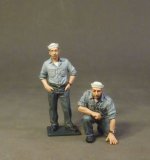
BH-16
THE SECOND WORLD WAR,
AIRCRAFT CARRIER FLIGHT DECK CREW,
SAILORS,
SCALE 1:30
(2pcs)
More to follow.........................................
The Interwar Aviation series covers aircraft that were developed and used between World War 1 and World War 2, and was known as the “Golden Age of Aviation.”
In the two decades between the end of World War 1 and the start of World War 2, military aviation underwent a complete transformation. The typical combat aircraft of 1918 was a fabric-covered externally braced biplane with fixed landing gear and open cockpits. Few aero engines developed as much as 250 horsepower, and top speeds of 200 km (120 miles) per hour were exceptional. By 1939 the first-line combat aircraft of the major powers were all-metal monoplanes with retractable landing gear.

Most early aircraft carriers were conversions of ships that were laid down (or had even served) as different ship types: cargo ships, cruisers, battlecruisers, or battleships. During the 1920s, several navies started ordering and building aircraft carriers that were specifically designed as such. This allowed the design to be specialized to their future role, and resulted in superior ships. During the Second World War, these ships would become the backbone of the carrier forces of the US, British, and Japanese navies, known as fleet carriers.
USS Saratoga (CV-3) was a Lexington-class aircraft carrier built for the United States Navy during the 1920s. Originally designed as a battlecruiser, she was converted into one of the Navy's first aircraft carriers during construction to comply with the Washington Naval Treaty of 1922. The ship entered service in 1928 and was buttigned to the Pacific Fleet for her entire career. Saratoga and her sister ship, Lexington, were used to develop and refine carrier tactics in a series of annual exercises before World War II. On more than one occasion these included successful surprise attacks on Pearl Harbor, Hawaii. She was one of three prewar US fleet aircraft carriers, along with Enterprise and Ranger, to serve throughout World War II.
A U.S. Navy Aircraftcarrier’s deck crew exists to do one thing: to consistently put aircraft into the air and safely recover them after they launch. In order to make this happen, there exists a small army of flight deck facilitators, and each individual has their own role primarily designated by the color of the shirt they wear.

IWA-16
INTER-WAR AVIATION,
USS SARATOGA (CV-3),
SAILORS,
(2pcs)
Life on the flight deck is dangerous and taxing. Spinning propellers, grease everywhere, and a stiff sea wind that never stops are just a few of the things that must be endured for many hours at a time. The night and bad weather throw a whole other set of problems into the mix.
Yellow shirts are also worn by aircraft handlers and aircraft directors that shuttle aircraft around the carrier’s tight and chaotic deck.
Plane Handlers, who work under the direction of the yellow shirt wearing aircraft handlers, buttist in moving aircraft around the deck. They also can operate the carrier’s massive aircraft elevators, drive tractors and work as messengers and verbal liaisons.

IWA-17
INTER-WAR AVIATION,
USS SARATOGA (CV-3),
SAILORS,
(2pcs)
** PLEASE NOTE THESE SETS WILL ALSO BE AVAILABLE WITH GREY BASES TO ACCOMPANY THE BH100-300 DECKS.**

**PLEASE NOTE THAT THE BH FIGURES ARE THE SAME AS IWA, EXCEPT THE BASES ARE A DIFFERENT COLOUR**

BH-16
THE SECOND WORLD WAR,
AIRCRAFT CARRIER FLIGHT DECK CREW,
SAILORS,
SCALE 1:30
(2pcs)
More to follow.........................................


